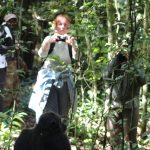Buganda
The Buganda Kingdom is one of the largest ancient monarchs that still reign in Uganda today. Established in the late 14th century along the northern region of Lake Victoria shores. And later gaining more power and prestige in the 19th century. Buganda over the course of history has had a number of theories which have argued about the origins of the mighty Kingdom. One of them stating that Buganda was in fact a small territory. Founded by the Bantu speaking people known as Muwaawa in the early 12th century.
Another theory speaks of two immigrant brothers Kintu and Kimera. Whose origin is traced back to Abyssinia modern day Ethiopia. The latter had staged an invasion on the native Balasangeye people defeating their then ruler Bemba Musota. And establishing the new Buganda with Kintu the King. The place where Bemba Musota was brutally murdered. Nakibuuka shrine became the coronation site of all the Kings of Buganda locally called Kabakas.
History of Baganda Kingdom
What cannot not be dismissed is that by the 19th century the Buganda Kingdom had cemented itself as the most influential kingdoms in the region. Most of its success stems from its incredible political, economic, social organization and the foreign infiltrations by the Arab and Christian missionaries during the reign of Kabaka Mutesa I. The Buganda kingdom exchanged valuable items with Arab traders including the most prominent slave trade. Following the coming of the British, Buganda Kingdom became a British protectorate after the signing of the famous Buganda agreement in 1900.
Because of their cooperation and assistance in administering over EastAfrica, Buganda was awarded autonomy by the British after independence in 1962. But the Buganda Kingdom saw worse days after independence when one of Uganda’s presidents His excellence Milton Obote saw Buganda’s different political identity. As a threat and devised means to abolish all monarchs entirely from the country and forcing the kings into exile. It was not until 1973 under the His excellence Yoweri Kaguta Museveni. That kingdoms were restored and the return of Kabaka Ronald Mutebi son of Mutesa II return. To claim his birth right as the king of Buganda and He has been reigning till date.
Political organization
The Buganda government is a well-oiled centralized government with an efficient administration and a political system focused around the Kabaka whose Kingship is hereditary. The Kabaka was called different names. Such as Ssabataka to mean ruler lands, Musota, Juuju and others which were meant to instill fear and most of all respect in His subjects. The Kabaka married from different clans and the heir to the throne took the mothers clan. Ensuring that all clans have an opportunity to give fourth a king which further united the kingdom. The kabaka appointed the Katikiro his prime minister. Who was responsible for the judicial and administration of the kingdom on behalf of the kabaka and a parliament called the Lukiiko the advisory council of the Kabaka.
The kingdom has 52 registered clans dividing the it into Sazas headed by saza chiefs. Gombololas headed by gombolola chiefs and Miluka under the miluka chiefs. All the chiefs under their jurisdiction exercised political and military responsibilities while reporting to the king. The Kabaka had royal guards who protected the court. But it was upon all able bodied men to contribute to the military in case of war. The Kabaka also appointed ministers such as the Omuwanika and Omulamuzi. Buganda had an indigenous central intelligence system of sorts. Where the kabaka appointed women to spy on influential people in the kingdom for political reasons and also sought advice from important women such as the Nnamasole (Queen mother), Lubuga (chief sister) and Nabagereka (chief wife).
Social organization
The people of Buuganda speak luganda and were organized in clans named after different mammals, bird, plant species such as Mpologoma clan (leopard) Nyonyi nyangae, Kobe. The clan chiefs were tasked with the responsibility of settling disputes in the clans and overseeing the day to day activities. The clans maintained unity through intermarriages and assigning certain responsibilities to specific clans such as the Ngeye clan drummed for the kabaka. The Mbogo clan were the kabakas messengers and entertainment was for the Butiko clan to mention but a few. The population was also divided into classes the Abambejja and Balangira the royal class. The Bataka the middle class and Bakopi the peasants.
Pre-colonial Buganda was a religious society that believed in the traditional religion of their forefathers. Lubale was the supreme god for whom they constructed shrines and was consulted through spiritual mediums. Lubale was assisted by other smaller gods such as the god for rain called Musoke, the god for war called Kibuuka among others. The Baganda people preserved their culture and traditions through taboos and norms. For example, it was taboo for a woman to serve her husband. While standing as the man was regarded as the head of the household in fact it was the husband’s obligation to provide for his family and the wife prepared the home and took care of the children.
Responsibilities
The woman had the responsibility of teaching the children how to behave in society. And the community also helped to raise the children hence the saying it takes a village to raise a child. The Baganda were agricultural farmers cultivating food crops. Such as Matooke but also kept domestic animals such as goats and sheep as well as folk. The goat for example played an important role after the marriage ceremony as the family of the bride was offered a goat if the wife was found to be virgin. And a hen or cock was offered to the brother of the bride during the marriage ceremony. The people held numerous colorful celebrations and performed rituals according to their needs. The marriage ceremony (kukyala and kwanjula) that brought two families together, the birth of twins, rituals performed for rain in times of drought among others.
The traditional dress
Was the gomesi or busuuti endowed by the women and kanzu ya milera for the men. The gomesi has its origins dating back to the 1900s. Where an Indian tailor named Gomesi designed the attire for the wife of King Daudi Chwa II of Buganda for her husband’s coronation ceremony. So attractive that all women in the kingdom desired to wear it making it popular. A floor-length dress, with a square neckline and puffed sleeves to boast. It is stanched to the waist by a sash tied around the waist and comes it a variety of fabrics including silk, cotton, linen. With a kikoyi worn underneath to make the gomesi fuller.
The gomesi is a dress for all occasions as it exudes respect from the lady wearing it. For entertainment, the Baganda enjoyed the maganda dance performed by skilled dancers to the rhythm of the drum. The drum (engoma) in Buganda culture was more than a musical instrument for entertainment. It was used in communication, for example welcoming important visitors, at the birth of twins, in mourning, during spiritual rituals and more and for each calling was a detailed beat that people understood.
This amazing communication tool was hollow made from tree trunk tapered on one end using reptile skin or cow hide, or bark obtained from fig trees. Beaten rapidly to a thin and flexible material that is left to dry and the drummer either struck it using sticks or hands. Although the drum can be identified as the most significant musical instrument to most tribes in the country. Other instruments such as the amandida, mbira and endingidi were used.
Economic organization
Pre-colonial Buganda’s economic scene was dominated by subsistence agriculture. The kingdom had fertile soils, assisted by a rich drainage system of numerous streams. As well as the oceanic sized Lake Victoria and two annual wet seasons that created this perfect atmosphere. Under which the people could cultivate. The prized Matooke in Buganda in all its varieties and forms is the staple food, including gonja (sweet plantain), the mbidde for making beer, nakabululu, musakala. And the kiwata which was used to supplement the feeds of domestic animals such as cows.
Food in Buganda
Preparing a matooke meal involves peeling using a knife. Then its wrapped carefully in green banana leaves set in cooking saucepan. That has already been piled with cut banana stems and immersed in water ready for steaming the bananas. The cooking process takes a while and when the bananas are soft. And ready they are mashed while still wrapped in the leaves and then placed back on fire to continue cooking.
After sometime the matooke are removed from fire and savory dish is prepared with any source of your choosing. Also the enva endilwa(vegetables) or you can enjoy it with luwombo a spontaneous dish that is part of the royal Buganda tradition. The berry also known as Mwanyi was grown dried and baked under the sun eaten as a snack. And also palying a ceremonial role as it was offered to guests as a sign of diplomacy.
Other crops such as sweet potatoes, maize, cassava are cultivated in the region and the introduction of cash crops by the British. Such as coffee, cotton, vanilla supplemented the income earned from selling food crops. Food was locally preserved through salting, sun drying, half cooking and also practiced a form of value addition. When they made ghee ( omuzigo) out of milk and bongo which is fermented milk. Women controlled the process of food preparation while men sought economic and political success.
Economic activities in Buganda
The Buganda Kingdom also engaged in the art of backcloth making. Until this day it used in many traditional ceremonies held in the region. After the acquisition of Buddu and Koki two towns skilled in the art of iron smelting, Buganda’s wealth increased as they begun trade with their neighbors in items such as spears, arrows, and other items made out of iron. Lake Nalubale (Lake Victoria) facilitated large scale fishing on the islands of Sesse using ginormous canoes.
The Ngege (tilapia) was the signature fish enjoyed by many. But also including catfish, Nile perch and lungfish. The Buganda kingdom realized epiphany following the Arabs that infiltrated into the interior of East Africa in search of slaves. The participation of the kingdom in long distance trade trading in items such as slaves. Saw Buganda increase in wealth through taxation and war booty and obtaining ammunitions that it used to raid and enslave its neighbors to feed the growing demand of slaves. Other items such as beads, glass, luxurious clothing was also exchanged.




